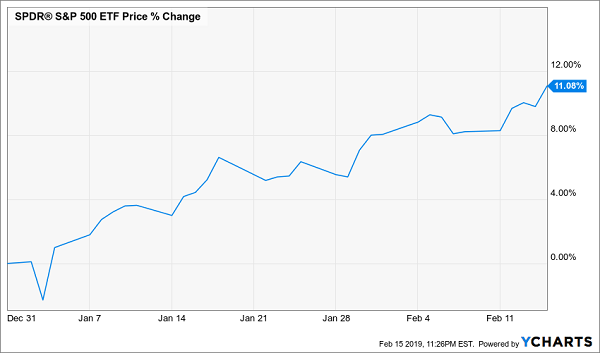If you own a diverse portfolio of closed-end funds (CEFs), you’re probably sitting on some nice gains in 2019—and there’s a great chance those gains have crushed the S&P 500.
So here, at nearly the two-month mark, it’s worth pausing to see where things stand, and where we should be looking for the next big winners.
Big Gains Everywhere You Look
So far, the average CEF is up 7.5% in 2019 and February isn’t even over. This run-up is everywhere, with only five of the nearly 500 CEFs tracked by our CEF Insider service slipping on the year.
The few funds that are down have nothing to do with the rest of CEF-land. The worst, the Morgan Stanley India Investment Fund (IIF), has slipped 3% only because India’s markets are taking a tumble—clearly an isolated incident.
In fact, all the CEF indexes CEF Insider tracks are up solidly, with dividends included, for 2019, and the gains are nicely spread out. This bodes well for the whole CEF market:
If It’s a CEF, It’s Probably Up

With the US stock market taking a hit in 2018 for no good reason, it stood the best chance of a strong showing as 2019 dawned. That’s why I wrote at the start of this year that the 2018 drop “handed us a golden opportunity to grab some double-digit bounce-back gains as 2019 rolls out.”
That’s what we’ve seen since:
Stocks Snap Back

Why You’re Not Too Late to the CEF Party
Note how the SPDR S&P 500 ETF (SPY), with an 11.1% gain, is up just a hair below the 11.8% posted by the CEF Equity Sub-Index, which is made up of many funds that invest in the same S&P 500 companies?
Understanding that difference is crucial as we make our next step forward.
Of the CEFs that are up on a price basis for 2019, 86.6% have seen their market prices rise more than their net asset values (NAVs, or what their underlying portfolios are worth). This means that many of these funds are no longer as steeply discounted as they were in late 2018.
If that sounds like you’ve missed the boat, don’t worry. The boat is still ready for plenty of new passengers, for two reasons.
First, the gap between their price gains and NAV increases isn’t that big—just 2.5% on average—which means that the move into CEFs has been orderly and slow, giving us more time to buy many funds before they’re overbought.
Second, and arguably more important, CEF discounts are still unusually generous. Today, the average CEF discount to NAV is 6.1%, compared to an average of 4.4% over the last decade.
And since the last decade includes the dark days of 2009, as well as other times CEFs were out of favor because of interest-rate fears (2013 and 2016) or general market volatility (2010, 2011 and 2018), we can conclude that today’s CEF discounts are far too low, considering the stability of their income and the health of today’s markets.
Fed’s Big Shift Not Yet Priced In
Looking ahead, CEFs are just beginning to be driven higher by a flow of dollars into these once-obscure investments, as shown by the healthy gains we’ve seen in these funds’ market prices.
The timing of this defies what CEF naysayers have been saying, namely that rising interest rates would hammer CEFs. But this “wisdom” is a moot point in 2019, as the Federal Reserve has already said it will slow, if not stop, rate hikes for the foreseeable future.
But even if rate hikes do resume, higher borrowing costs aren’t by themselves bad for CEFs, because here’s what most people miss: CEFs are not only debtors but creditors, too, which means they can also benefit from elevated borrowing costs.
And at the end of the day, what really drives CEF returns is the quality of investments available to fund managers at bargain prices. Following 2018’s selloff, there’s still no shortage of deals available on assets that can deliver superior returns for CEFs (and their investors).
So where does that leave us? With CEFs still at a discount and critical factors, like the Fed’s move to the sidelines, not fully priced in, we’re still in a great position to buy and tap the outsized 7%+ dividends many CEFs offer.
My 4 Top CEF Picks Are Still Cheap (but time is running out!)
With the market rebounding and CEF discounts evaporating, I’ve pushed out a freshly updated list of CEFs you need to buy now—while they’re still cheap!
These 4 funds are the perfect “set-it-and-forget-it” investments. Thanks to their ridiculously wide markdowns, I’m calling for double-digit price upside, on average, in the next 12 months.
But even if the market takes another tumble, these crazy discounts have us covered, because they mean these 4 ironclad CEFs will dig in and hold their own in the storm.
I haven’t even mentioned the best part: these 4 buys pay an average dividend of 7.5%, with one even sending an incredible 8.4% cash payout your way!
So right now you’re probably wondering why these incredible deals exist.
You’re right to ask. Two reasons:
- As I mentioned, the Fed’s move to the sidelines hasn’t yet been priced into the CEF market, and …
- These CEFs are small, with market caps below $1 billion—and that keeps them off the herd’s radar, giving us even more time to buy in as the bulls stampede.
But our chance is vanishing fast, and I don’t want you to miss out. Click here now to get full details on these 4 incredible “forever” funds: names, tickers and everything I have on each one—all boiled down into concise, easy-to-read English.
